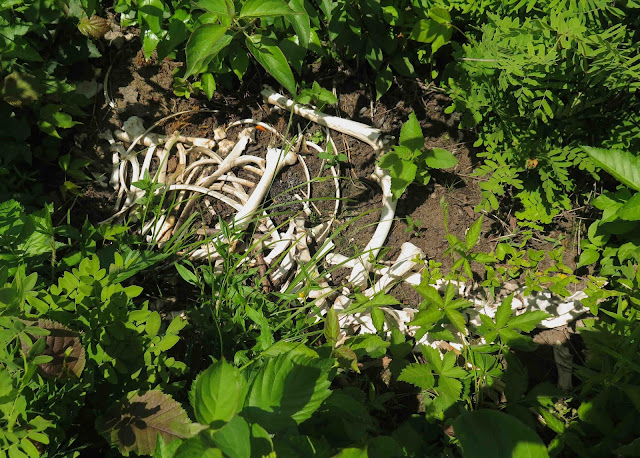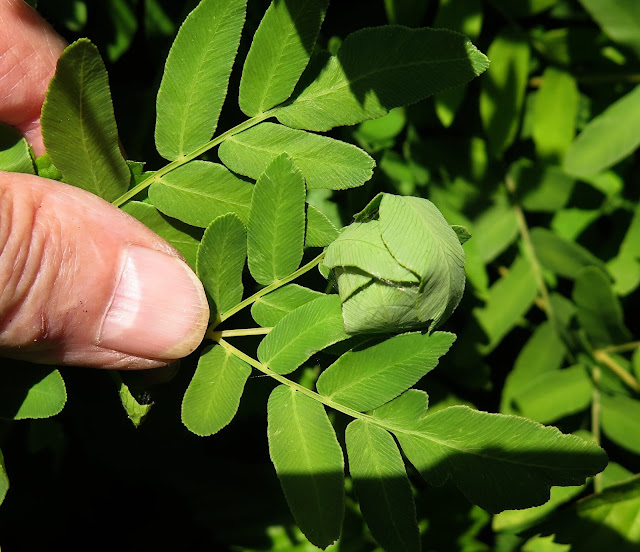Oh my, just LOOK at these gorgeous Blue Flags! This old photo of mine showed up in my Facebook Memories yesterday, and it reminded me of how much I've been missing the past few weeks. During the middle part of May, I suffered an intestinal illness that laid me low and sapped my energies even after the acute symptoms subsided. So I haven't been wandering the woods and waterways as has been my wont, or even if I did go out for short forays, I didn't feel enough oomph to post blogs about what I found out there. But man, I sure would hate to miss seeing these beauties this year! So I dragged my canoe from under the porch, strapped it to the roof of my car, and set off to go look for them where I knew they grew along the Hudson River.
Lucky for me, the day was gorgeous, and the river ran smooth as silk as I set off to explore the banks and islands of the Hudson at Moreau.
I always feel profoundly at peace paddling this stretch of the river between the Spier Falls and Sherman Island dams, where forested mountains fall right down to the water, and bouldered shores are adorned with some of our most beautiful native plants. Both sides of the Hudson here are part of Moreau Lake State Park, their pristine beauty unmarred by most human development, even though I still can hear autos passing along Spier Falls Road as I mosey along close to the Saratoga County side of the river.
Where the banks are undercut by the force of the river's current, these gracefully curving fronds of Long Beech Fern formed a lovely drapery over the shadowed hollows.
Inching as close as possible to the rocky banks, I spied some spikes of small white florets nestled among the grasses. Ooh, could these be Shining Ladies' Tresses, our earliest species of Spiranthes to bloom around here?
Indeed they were! Spiranthes lucida, one of our region's nearly 60 species of native orchids, distinguished from other white-flowered Spiranthes by its florets' yellow lower lips, as well as its early bloom time. In my experience, this little orchid does seem to like to grow along river banks, and thus must be able to tolerate the inundations of seasonal flooding. And in this particular stretch of river, varying water levels are caused by upstream and downstream hydropower dam operations.

Over the past 30-plus years I've been paddling this catchment, those varying water levels appear to have killed most of the deciduous trees that once forested the little islands that stud the Hudson along this section. (Abundant beavers also contributed to the deforestation.) For various reasons, what once were lower water levels following spring flood are now year-long high water levels, and this change of hydration has changed the habitat of these islands from shaded forest to sun-baked wet meadow. On this day, the water level was remarkably low, revealing broad swaths of muddy shoreline, because the river water had been lowered for over a week while the downstream dam was undergoing maintenance and repair. This catchment was still in the process of refilling.

I stopped off to explore this island, curious to see if a second orchid, the Tubercled Orchid, was still abundant along the shore. I could not find a single one this year (orchids can be quite fickle), but I was quite surprised to come upon this nearly intact deer skeleton lying amid the Royal Ferns. I know that sometimes coyotes chase deer across the frozen river, where the coyotes have surer footing than the deer do on the ice. I wonder if that's how this creature met its end.
I was curious to see if the Royal Ferns were once again serving as birthing centers for some insect larvae (moth or cutworm?). And indeed they were! In plant after plant, the terminal leaflets had been drawn into hollow orbs wrapped by silken threads, thereby creating chambers where the larvae sheltered, consuming the fern tissue before undergoing pupation.
I reported finding these same pupation chambers on this same island a year ago and posted information about them on
this blog at that time.
Although my explorations of this island's interior were hampered this year by the extensive spreading of Poison Ivy, I did enjoy a few floral finds, such as this abundant patch of our native Dwarf Forget-me-nots (Myosotis laxa).
Here's a close-up of those wee little flowers to demonstrate how adorably tiny they are.
Lots of other blue flowers make this island their home as well, especially abundant populations of Blue-eyed Grass (Sisyrinchium sp.).
Another populous wildflower on the island are these bright-yellow Small Sundrops (Oenothera perennis).
Although I did find a few scattered plants of Blue Flags (Iris versicolor) on the island, I wanted to find the abundant patch of them I had photographed a few years ago and so headed across the river to the Warren County shore. And sure enough, there they were, just as glorious as ever, picked out by the sunlight to glow against the deep shade of the forest behind! Oh yes, I delighted to bask in the beauty of them! But because of that full sunshine creating deep shadows and bright highlights, I was not able to achieve the marvelous depth of color of the flowers that I'd achieved in my former photo, taken under conditions of bright overcast, which eliminated both shadows and highlights. But still . . . . Oh joy!
And of course, the addition of a Tiger Swallowtail nectaring among the blooms only added to the beauty.
Too bad this neighboring gigantic clump of Yellow Iris (Iris pseudacorus) threatened to spoil my elation. Yeah, yeah, the flowers are gorgeous, but this plant is one of the most destructive invasive species imaginable. Left to do its thing, this single clump could completely overtake this entire shoreline, supplanting every native wildflower in its way. I would need a pickaxe to uproot it, but at least I had my small Leatherman tool with a knife blade to cut every flowering or budding branch, so no seeds could be dropped in the water this year to spread new plants down the shore. I will report its presence here to the Invasive Management Program folks, and hope they might bring their heavy-duty uprooting tools to eradicate it from this stretch of shoreline anyway. I hope to always be able to return to "my" spectacular patch of native Blue Flags.

I'm on my way to trash these interlopers. And I urge all my readers to be on the look-out for any occurrences of Yellow Flags they might find and seek to destroy them as well.

















1 comment:
Glad to read that you are back on your feet and back at your paddle. It would be a shame to miss this wonderful season. Beautiful photos and fascinating post, as always.
Post a Comment